Security cameras are a crucial part of modern security systems. Whether you’re aiming to protect your home, office, or any valuable property, a well-installed camera can be your best ally. In this guide, you’ll learn everything about how to install a security camera system yourself without professional help. This DIY guide is perfect for beginners and enthusiasts looking to secure their property efficiently and affordably.
1. Why You Need Security Cameras
In today’s world, security threats are unpredictable. Having a visible security camera can deter criminal activity, provide evidence when needed, and give you peace of mind. Not only do cameras help reduce break-ins, but they also allow remote monitoring of your property. With rising crime rates in both urban and suburban areas, camera systems are no longer optional — they're essential.
2. Choosing the Right Type of Camera
Before you install, select the right type of camera. Options include dome, bullet, PTZ, and wireless IP cameras. Each has a unique purpose. Dome cameras are ideal for indoor coverage, while bullet cameras are great for outdoors. PTZ (Pan Tilt Zoom) cameras offer more control, and wireless models are perfect if you want an easier setup without hardwiring.
3. Understanding Your Surveillance Needs
Evaluate your space. Are you protecting a small home or a large warehouse? Understand how many cameras are needed, and what areas are most vulnerable. Mapping your surveillance zones helps in avoiding blind spots. Knowing this in advance saves time and ensures efficient installation.
4. Indoor vs Outdoor Cameras
Outdoor cameras should be weatherproof and have infrared night vision for round-the-clock surveillance. Indoor cameras don't need such rugged features but may require better aesthetics to blend into your interior. Place them near entrances, hallways, or main rooms to maximize coverage.
5. Tools and Materials You’ll Need
For a successful DIY camera installation, prepare these tools:
-
Drill and bits
-
Screws and anchors
-
Ethernet cables (for wired systems)
-
Ladder
-
Mounting brackets
-
Power adapter or PoE switch (if applicable)
Having everything on hand will make the process faster and more organized.
6. Preparing the Installation Site
Start by testing the camera feed on your system before mounting. Hold the camera in place where you plan to install it and check the angle on your monitor. This prevents rework and helps you achieve the best field of view. Make sure no obstructions like trees or décor interfere with the feed.
7. Mounting the Camera
Mark the screw holes with a pencil. Drill holes, place wall anchors, and screw the mounting bracket into place. Once the bracket is secured, attach the camera and tighten its mount. Ensure the angle covers the maximum area without blind spots. For outdoor cameras, consider overhead corners to reduce tampering risks.
8. Running the Cables (If Wired)
Cable management is crucial for aesthetics and security. Run Ethernet or power cables along walls, ceilings, or through conduits. Use clips or cable raceways for a neat finish. Keep cables away from sharp edges and power lines to avoid interference or damage.
9. Connecting to Power and Network
Wired cameras need a power supply or PoE switch, while wireless ones require stable Wi-Fi. Plug your camera into the power source and connect to your router. If you're using NVR or DVR, plug the video cable accordingly. Test the feed to confirm everything works properly.
10. Configuring Your Camera System
Download the manufacturer’s app or software. Follow the prompts to configure settings like:
-
Motion detection sensitivity
-
Recording schedule
-
Cloud or local storage
-
Alerts and notifications
This step personalizes the camera to suit your needs, from home security to commercial surveillance.
11. Testing and Troubleshooting
Once installed, test all cameras. Check video quality, angles, recording, and alerts. Walk in front of the camera to test motion detection. If something doesn’t work, review connections and settings. Ensure your app receives alerts and that footage saves to your preferred location.
12. Regular Maintenance and Upkeep
Clean camera lenses monthly to avoid blurry footage. Check cables and mounts every few months for wear or tampering. Update firmware to keep your system secure and functional. A well-maintained system lasts longer and offers more reliable protection.
13. Advanced Features to Consider
Modern systems offer AI detection, facial recognition, and smart alerts. These features improve surveillance accuracy. Some models integrate with smart home ecosystems like Alexa or Google Assistant. Explore these for added convenience and automation.
14. When to Hire Professionals
While DIY works for most homes, larger commercial spaces may need a professional touch. If you're unsure about network configurations or advanced setups, consider hiring experts. Companies like this trusted security installation team offer professional solutions to make sure your system is foolproof.
15. Adding Access Control for Extra Safety
For enhanced security, combine your camera system with access control. This allows you to monitor who enters your property and when. A strong access control system, like those offered by this reliable provider, can integrate seamlessly with your cameras for total security coverage.
FAQs
1. Can I install a security camera without drilling?
Yes, many wireless cameras offer adhesive mounts or magnetic bases. However, drilling provides a more secure and permanent installation.
2. What’s the best height to mount a security camera?
Ideal mounting height is 8-10 feet. This prevents tampering and offers a wide-angle view.
3. Do I need internet for my security cameras to work?
For remote viewing, yes. Some local systems can record without the internet, but features like alerts and cloud storage require it.
4. How many security cameras do I really need?
It depends on your space. Typically, at least one for every entrance, main hallway, and outdoor perimeter is ideal.
5. Are wireless cameras reliable?
Yes, if you have a strong Wi-Fi signal. Modern wireless cameras offer high-quality video and stable connections.
6. How often should I check or maintain my camera system?
A monthly check for camera angles, cleanliness, and cable integrity is recommended. Firmware should be updated as released.

